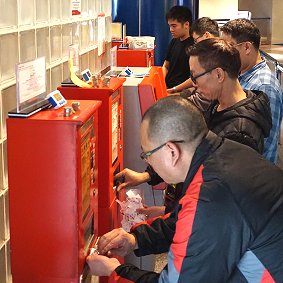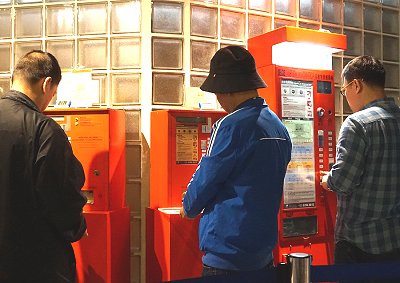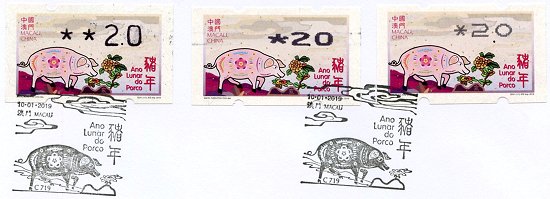|
|
 |
| 2019, the Lunar Year of the Pig (Ano Lunar do Porco) |
The 'Lunar Year of the Pig' design is the seventh in the series of annual ATM issues first released in 2013 dedicated to the twelve animals of the Chinese zodiac.
The new issue was available from January 10th 2019. As in previous years, this issue complements a set of four 'traditional' stamps, one souvenir sheet and a domestic post paid card, dedicated to the same subject and issued on January 5th and 8th, respectively. |
 |
| Based on the lunar calendar, the Year of the Earth Pig started on February 5th 2019, and will end on January 24th 2020. |
 |
The design is by the local artist Anita Fung Pou Chu.
The rolls of labels were manufactured by the Dutch company Joh. Enschedé Security Print, using gummed paper with security fibres. The issue's information is micro printed at the bottom of the labels. Bottom left we find the name of the designer (ANITA, FUNG POU CHU des.). At lower right, there is the reference number of the issue and the stamp (S241 1/1), and then comes the manufacturer and year (JES Imp. 2019). Every 5th label has a 4-digit number preprinted on the back to indicate the number of labels remaining on the roll.
The total printing run for this design was one million labels. |
Following the line begun at the Macao 2018 stamp exhibition (see article, also published in VARIABLE 50), the new 'postage label' was available from stamp vending machines installed in three locations only; the main post office in Largo do Senado (right image), the Museu das Comunicações, and the Almirante Lacerda branch. This was to facilitate access of the new issue to collectors and also to simplify maintenance procedures.
In addition, and as on previous occasions, CTT had an access limit of 10 minutes per person per machine.
In the same vein, during the first day of sale, the philatelic service set limits on the sale of the associated philatelic products. |
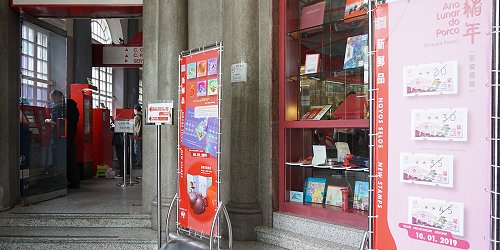 |
 |
At the end of 2018, Correios de Macau replaced most of the Klüssendorf and Nagler vending machines integrated within the postal company's kiosks in public areas, with the new Newvision equipment (see article).
However, some of the Nagler machines which had been removed were reinstalled in the hall of the main post office and in the Communications museum, and will remain in operation for a few more years, mainly for philatelists/collectors.
| In January 2019, CTT had six stamp vending machines installed in the main post office. From left to right, two Newvision Elite kiosks, one Klüssendorf 631, one Nagler 714, and two Nagler 104s. |
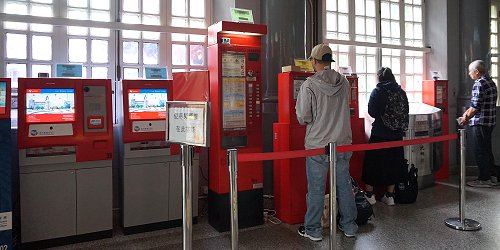 |
| The Museu das Comunicações (right and images below)also had six machines in operation, two Nagler 104s, one Newvision Elite, two Nagler 714s, and one Klüssendorf 631. |
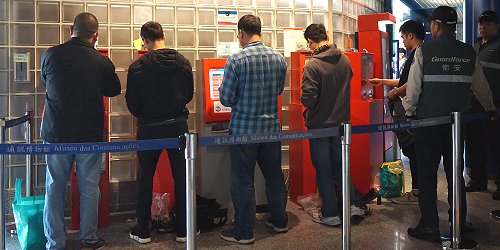 |
Finally, in the access area to the Almirante Lacerda post office, which already had a Nagler 104 machine, they added a new Newvision Prestige wall mounted kiosk (images below).
 |
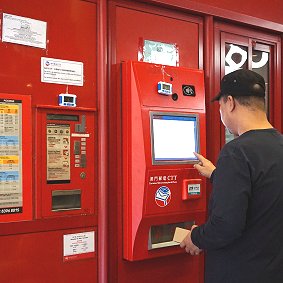 |
| Therefore, with all the different stamp vending machines installed on the date of issue, the new design could be obtained with three printing varieties; Klüssendorf, Nagler and Newvision. In all cases, the model and the status of the print cartridges used by the machines results in the issue of stamps with face values printed in different shades of black ink. |
 |
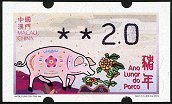 |
The Klüssendorf 631 kiosks have twelve programmed values - 2.0 (basic domestic rate), 3.0, 3.5, 4.0, 4.5, 5.0, 5.5, 8.0, 10.0, 12.0, 30.0 & 50.0 patacas. Payment is only possible with coins. |
 |
 |
Special first day postmark and first day cover |
 |
| The philatelic service sold four-value sets, first day covers (right) and information brochures. All the stamps used in these philatelic items are printed with the back-office desktop Klüssendorf printers. |
 |
The Nagler N104 vending machines (below, left) are programmed with six different values - 2.0, 3.0, 3.5, 4.5, 8.0 & 12.0,
plus customers were also able to obtain stamps with two 'residual' values, 0.5 & 1.0 patacas, automatically printed by the machine when coins are inserted for a higher value than the requested stamp value.
The Nagler N714 machines (below, right) have seven programmed values - 2.0, 3.0, 3.5, 4.5, 5.0, 8.0 & 12.0 patacas, and do not issue 'residual' values.
Both machines accept coin payments only. |
 |
 |
 |
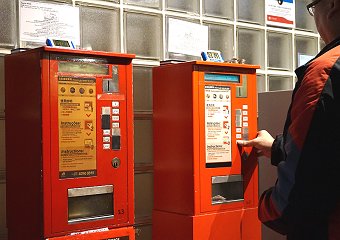 |
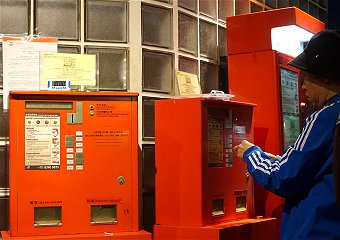 |
 |
Finally, the new Newvision Elite and Prestige postal kiosks offer the direct purchase of stamps with the same twelve values programmed in Klüssendorf kiosks - 2.0, 3.0, 3.5, 4.0, 4.5, 5.0, 5.5, 8.0, 10.0, 12.0, 30.0 & 50.0 patacas.
Unlike the Klüssendorf and Nagler equipment, where the the face value is always printed in a 4 or 3-digit format, respectively, Newvision kiosks always print a security asterisk in front of the face value, which can consequently have 3 or 4 digits. |
 |
 |
Payment can be made with coins or with the Macau Pass, a local contactless prepaid card. After the operation, the machine issues a receipt printed on thermal paper (right image, full twelve-value set). |
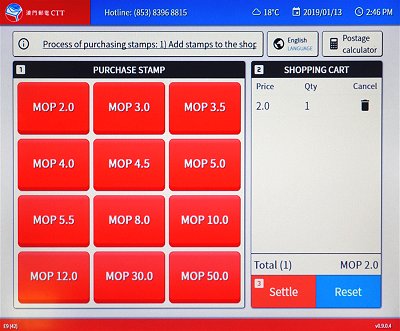 |
| 2019. New definitive issue 'Grande Baia Guangdong-Hong Kong-Macau' |
In 2019, four years since the release of the last definitive issue, Correios de Macau issued a new regular label design for its postal kiosks. This new design gradually replaced the previous definitive issue 'Ruas e Ruelas Antigas', available since June 2015 (see article, also published in VARIABLE 37), and reprinted a year after (article and VARIABLE 45).
Unlike the commemorative or annual issues dedicated to the Chinese Zodiac, which have limited print runs and sold to exhaustion of stocks - (in certain machines), the definitive designs have unlimited print runs and reprints, produced as and when required, and are usually available from all the kiosks in service.
| The new issue is dedicated to the 'Guangdong-Hong Kong-Macau Greater Bay Area' project. This involves the creation and development of a large metropolitan region on the southwest coast of China that includes the Special Administrative Regions of Hong Kong and Macao, and nine cities of the Guangdong Province; Guangzhou, Shenzhen, Zhuhai, Foshan, Huizhou, Dongguan, Zhongshan, Jiangmen and Zhaoxing, with a population of more than 70 million people. This ambitious plan is a great challenge for Macao, and also a great development opportunity for tourism and entertainment, providing a conduit for relations between China and the Portuguese-speaking countries and Europe in general. |
|
 |
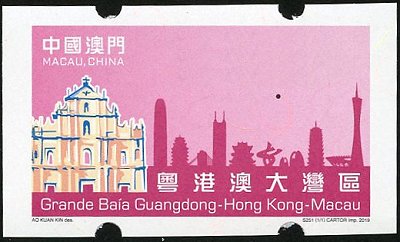 |
|
The designer is Ao Kuan Kin. The composition shows an image of the Ruins of St. Paul's Cathedral, undoubtedly the most emblematic and well-known monument of Macau, along with a profiled image of the main buildings of the other ten cities.
The rolls of 2000 labels were manufactured by the French company Cartor Security Printing, using gummed paper with security fibres and offset printing. |
| The information about the issue is microprinted at the bottom of the labels; on the left, the designer (AO KUAN KIN des.), on the right, the reference number of the issue and the stamp (S251 (1/1)), the manufacturer and year (CARTOR Imp. 2019). There is a preprinted number on the back of each 5th stamp, showing the number of labels left on the roll. |
|
 |
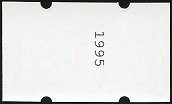 |
| In addition to the labels for use in postal kiosks, Correios de Macau issued a series of four stamps and a souvenir sheet dedicated to the same theme on September 26th 2019, all designed by Ao Kuan Kin. Each stamp of the series is dedicated to one of the four most important cities of the 'Grande Baía', Hong Kong, Macao, Guangzhou and Shenzhen. |
|
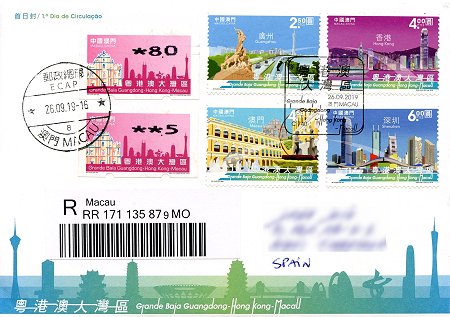 |
| During the first few days of issue release, the new design was only available from the stamp vending machines installed in the main post office in Largo do Senado (images), the Museum das Comunicações, and the Almirante Lacerda branch. This was to cope with the large number of collectors and dealers using the machines and to optimise maintenance procedures. |
|
 |
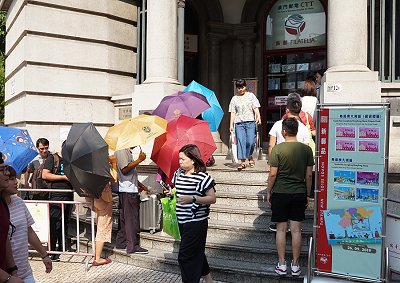 |
In addition, and as on previous occasions, CTT imposed an access limit of 10 minutes per person per machine. In the same vein, during the first day of sale, the philatelic service set limits on the sale of associated philatelic products.
 |
|
In September 2019, the GPO or main post office in Largo do Senado had six stamp vending machines installed, two Newvision Elite kiosks, one Klüssendorf 631, one Nagler 714, and two Nagler 104s.
The Museu das Comunicações (left and images below) also had six machines in operation, one Klüssendorf 631, one Newvision Elite, two Nagler 104s and two Nagler 714s. |
On May 30th 2019 CTT announced new postal tariffs, the first changes since 2014. Unlike in most European countries, only the basic domestic rate increased in Macau, from 2 to 2.5 patacas, while international rates for letters and packets were unified and / or reduced.
| Following these changes, Correios de Macau decided to disable the button (another one!) for the printing of stamps with the 2.0 patacas value in the few Klüssendorf and Nagler machines left in service. It is not possible to change the programmed values, so it is no longer possible to obtain the current domestic tariff on these machines. |
|
 |
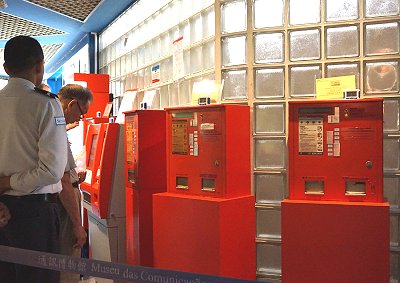 |
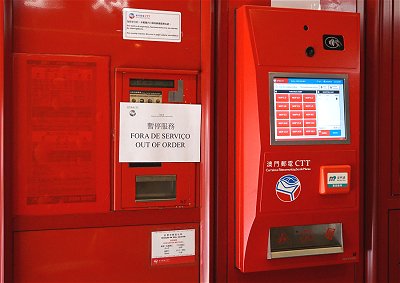 |
|
Finally, the Almirante Lacerda post office had a Nagler 104 machine (out of service after the change of postal rates), and a Newvision Prestige wall mounted kiosk (image).
Unlike the old Klüssendorf and Nagler vending machines, the new Newvision postal kiosks can have changes in postal rates remotely updated. |
Therefore, given the different stamp vending machines installed on the day of issue, the new design was available with three printing varieties; Below, from left to right, Nagler, Klüssendorf and Newvision.
 |
After the disabling of another button, the only two Klüssendorf 631 kiosks in operation have eleven programmed values - 3.0, 3.5, 4.0, 4.5, 5.0, 5.5, 8.0, 10.0, 12.0, 30.0 & 50.0 patacas.
Payment is only possible with coins. |
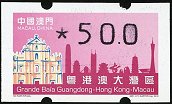 |
 |
Similarly, with the 2.0 patacas button disabled, the Nagler N104 vending machines are programmed with five different values - 3.0, 3.5, 4.5, 8.0 & 12.0, plus customers were also able to obtain stamps with two 'residual' values, 0.5 & 1.0 patacas, automatically printed by the machine when coins are inserted for a higher value than the requested stamp value.
The Nagler N714 machines have six programmed values - 3.0, 3.5, 4.5, 5.0, 8.0 & 12.0 patacas, and do not issue 'residual' values.
Both machines accept coin payments only. |
 |
 |
 |
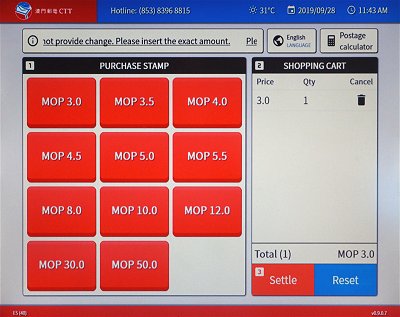 |
|
 |
After the change in postal rates, Correios de Macau removed the former domestic mail rate 2.0 patacas in all Newvision Elite and Prestige kiosks, so these machines offer the direct purchase of stamps with eleven programmed values - 3.0, 3.5, 4.0, 4.5, 5.0, 5.5, 8.0, 10.0, 12.0, 30.0 & 50.0 patacas (upper screen).
However, on the occasion of the release of the new design, Correios added four new values (2.5, 6.0, 14.0 and 21.0) to the programmed rates at the four kiosks installed in the three listed locations only (lower screen).
These values correspond to new postal rates including the domestic mail rate. |
|
 |
|
 |
Therefore, on the date of issue the four Newvision kiosks offered the direct purchase of stamps with 15 programmed values - 2.5 (new domestic mail rate), 3.0, 3.5, 4.0, 4.5, 5.0, 5.5, 6.0, 8.0, 10.0, 12.0, 14.0, 21.0, 30.0 and 50.0 patacas. |
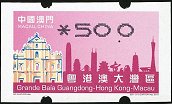 |
Payment at these postal kiosks can be made with coins or with the Macau Pass, a local contactless prepaid card. After the operation, the machine issues a receipt printed on low quality thermal paper (upper image, full fifteen-value set).
As a clear illustration of the replacement of the old equipment by the new Newvision kiosks, the philatelic service, for the first time with this design, sold the usual four-value sets, first day covers and information brochures all with stamps printed with a Newvision machine instead of a Klüssendorf.
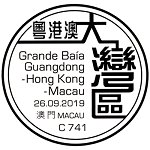 |
Special first day postmark and first day cover |
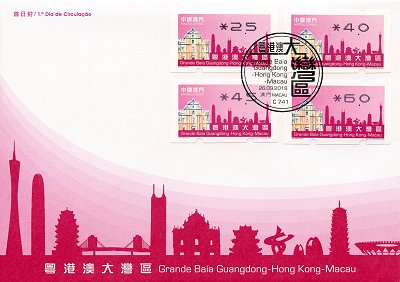 |
| The set includes stamps with the new values 2.5, 4.0, 4.5 and 6.0 patacas, corresponding to the current domestic and the main international non-priority and priority mail rates, in the first weight step. Most of these values cannot be obtained from the Klüssendorf and Nagler vending machines. |
| Variable value stamps for immediate use. Farewell to manned kiosks |
| From June 17th 2019, CTT programmed a new 'EMS' advertising block on the variable value stamps issued by the equipment installed in the Rua da Barca postal kiosk (see next section). This same block appeared, over the following weeks, on the stamps issued by the rest of the machines. |
|
 |
These variable value stamps are issued by a counter computer system installed in post offices. The stamps are printed on white labels, size 100 x 28 mm. and include information on the date and office of issue. For collecting, CTT does not allow the purchase of mint stamps, and therefore these can only be obtained as postage for letters and packets.
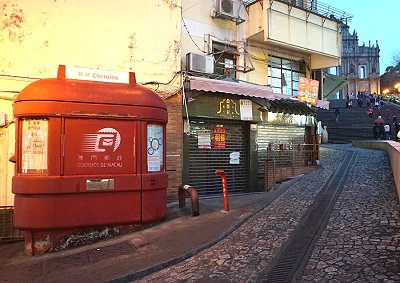 |
|
Between 1985 and 1999, Correios de Macau installed ten manned postal kiosks throughout the city, in areas with a high demand for postal services and not having any post offices nearby. These small kiosks were staffed for a few hours by Correios staff and offered basic postal services. With a questionable demand for them, CTT began to slowly remove some of these kiosks over time, and by the end of 2010 there were only two left in service. One, located at the the foot of the stairway leading to the Ruins of St Paul’s (upper image) focused mainly on tourists and the second was located in a square in Rua de Barca, in a very busy commercial district (below).
With the change in postal habits and demand their usefulness slowly decreased. After more than thirty years in service, CTT decided to close them permanently and may possibly replace them in the future with new Newvision self-service postal kiosks.
The kiosk installed near the Ruins of St Paul's was closed on May 18th 2019 and the one located on the Rua da Barca on December 31st 2019. |
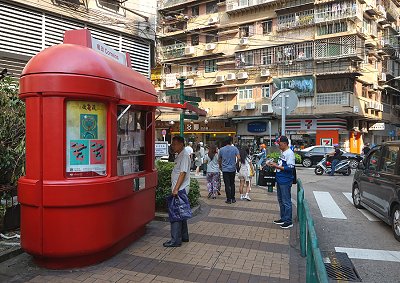 |
The contents of this page and the website in general are protected by copyright.
The unauthorized copy of the text and / or images is prohibited.
ATM Web - Spain and Latin American Postal Services: http://www.ateeme.net
© J. Jove - ATEEME. Variable value stamps study group. All rights reserved
This page was created in April 2019 and last updated:
10.01.20
. English edition last rewritten by J. Gareze (10.01.2020)
|







